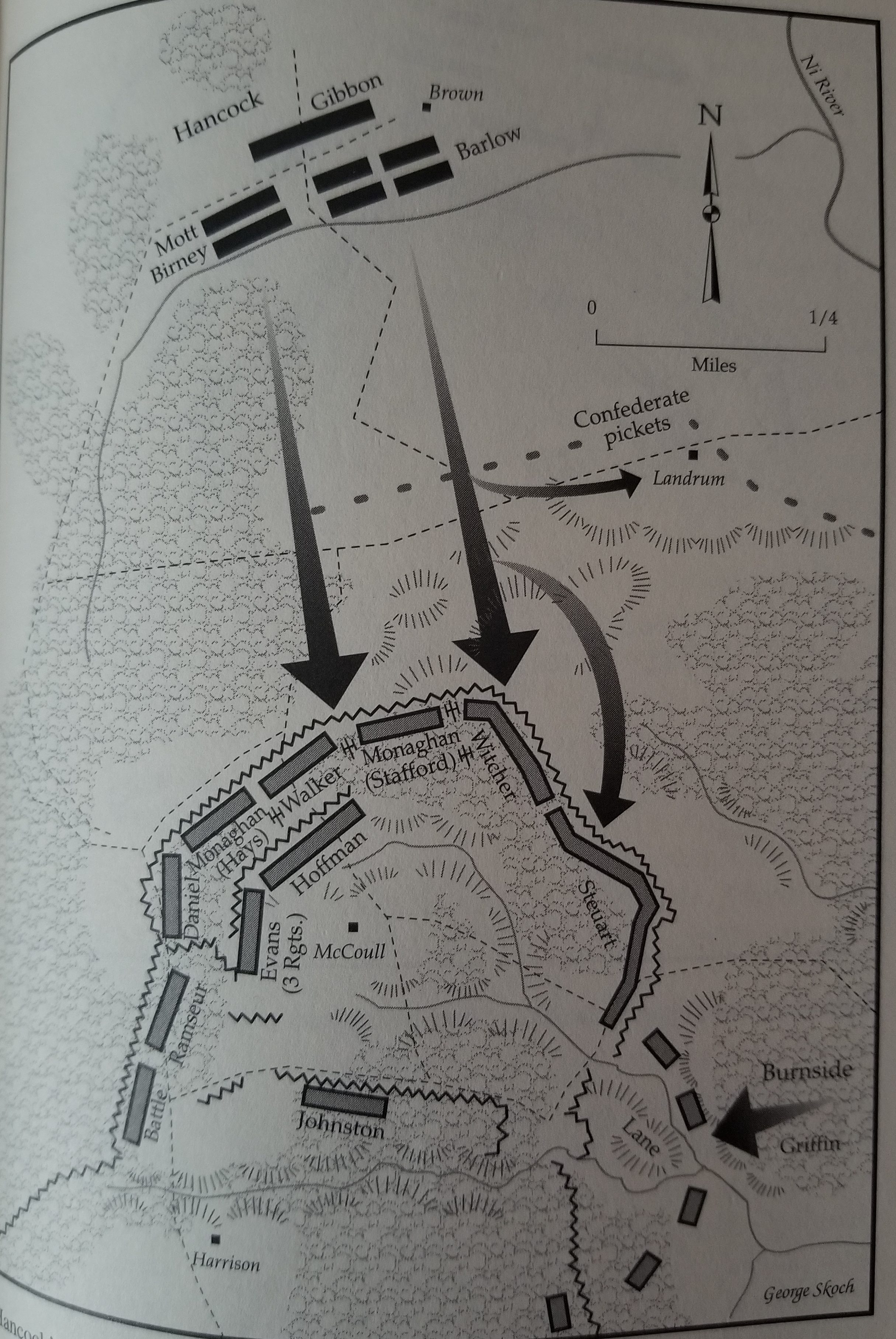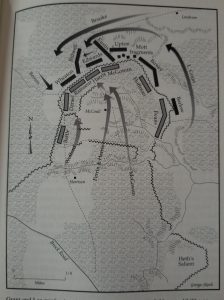26th Michigan: “Through those long hours of murderous conflict”

Emerging Civil War welcomes guest author Nathan Varnold.
When we look back over the four battlefields here in the Fredericksburg area, no ground holds more harrowing scenes, more gruesome details, nor more emotional devastation than the ground in and around the Mule Shoe at Spotsylvania Court House. Even though the Mule Shoe measures 1800 yards at the base and 1320 yards from the base to the Apex, we focus on the area known as the “Bloody Angle.”[1]
We remember this angle for the brutality of a fight that lasted over twenty hours. We remember the rain that pounded atop Union blue and Confederate gray as they struggled for survival. Above all, we remember the results. Not who claimed “victory,” if there could be such a thing at a place like this, but the scenes of death and the mental strain experienced by both Union and Confederate soldiers. Every regiment experienced May 12, 1864 differently. Nathaniel Harris’s Mississippians stood on the line from 7 AM until 3 AM on May 13. The 126th Ohio never made it to the angle but suffered heavily. The 26th Michigan battled on both the eastern and western sides of the Mule Shoe.
Organized in Jackson, Michigan from September-December 1862, the 26th Michigan Regiment missed the battles of Antietam, Fredericksburg, Chancellorsville, and Gettysburg. Instead, the regiment guarded Washington D.C. until April 1863. From April to October 1863, the regiment became attached to the Department of Virginia. In October, the 26th Michigan transferred to the Army of the Potomac. Even though the regiment missed the bloody battles of 1862 and 1863, the Overland Campaign offered the regiment more than its fair share of military combat. This is the story of the 26th Michigan at Spotsylvania Court House, May 12, 1864.
Part of Winfield Scott’s II Corps during the Overland Campaign, the 26th served in Colonel Nelson Miles’s First Brigade of Francis Barlow’s First Division. Stepping off from the Brown House – about 1 mile north from the apex of the Mule Shoe – the II Corps attack began at approximately 4:30 A.M. Captain Benjamin Batchelor simply stated, “The orders were to move forward quietly as possibly until close to the works when with fixed bayonetts [sic], they were to rush forward at a double quick and yell.”[2] Packed in a compact formation – taken from Colonel Emory Upton’s attack on May 10 – Barlow’s Division smashed into the apex. The blue wave sliced through the abatis and jumped over the breastworks.

Major Nathan Church declared the Wolverines as “the first to reach the works (striking them immediately at the Angle), which were gained after a fierce hand-to-hand fight with the bayonet.”[3] A Michigan flag was planted on these lines and not even the fire from a lone artillery piece stalled the Union attack.[4] From this point Barlow’s Division swallowed up the eastern portion of the Mule Shoe. The onslaught continued down the western portion where the remainder of Hancock’s Corps – under the division commands of John Gibbon, David Birney, and Gershom Mott – slugged it out with the Confederate forces under Edward Johnson. A soldier in the Stonewall Brigade wrote that “The battle was raging from traverse to traverse, our men standing boldly to our duty.”[5]
The Union army appeared on the verge of success; however, the same overpowering weight that brought the Union army early triumph also caused the attack to falter and slowly burn out. Major Church described the chaos as men “mingled up with men of other regiments” as an organized mob formed within the salient. Newton Kirk, writing between 1907-1909, recalled, “From the time we struck the enemy’s works there was no effort to keep up any Company or Regimental formation. We passed up their lines, every man a commander with full power to take prisoners, and shoot down all who resisted their authority.”[6] The attack continued and Barlow’s Division pursued the escaping enemy approximately a mile in the rear where the Union wave encountered the Confederate second defensive line.
This second line fell under the command of John B. Gordon. At this point, Gordon sensed a weakness. If he could hit the unorganized Union forces with a large organized force the Confederates might be able to gain the eastern portion of the Mule Shoe back. Gordon’s Georgians hit the unsuspecting Union army with force. As Gordon’s Division moved forward a Confederate soldier noted that the blue and the gray became a “dense, surging mass;” but the mass helped Gordon’s attack dwindle the Union wave. [7] “Having unavoidably become much broken up, and being opened on by a heavy fire from the woods on our right,” stated Major Church, “we were obliged to fall back, losing over half the ground we had taken from them.”[8] Gordon’s men had successfully repulsed the Union left wing, which caused Union soldiers to take shelter on the outside of the Confederate Mule Shoe. The next 20 hours became a contest of life or death.[9]
From the outer portion of the breastworks, orders came down to the 26th to readjust the line and support the Union attack on the western angle. The new formation brought the regiment to the apex – the point where they hit the Confederate line – an extended line to the right near the location of a 22-inch diameter oak tree.[10] The 26th crept along the outside of the breastworks and settled into a gruesome close-quarters fight divided by a parapet. Historian Earl J. Hess called the parapets that separated the armies “a blessing and a curse.” The parapet allowed both armies to stay separated from one another but also became a murderous killing ground. Atop the parapets members of the 26th killed freely with bayonets and clubbed muskets; with haste and intensity.[11]

At this point, the Wolverines fought their foe for approximately half an hour. After that time a handkerchief appeared on an enemy ramrod. The Michiganders stopped firing and hollered for the enemy to venture over when a gray clad line stood up and readied themselves to cross the parapet. Just behind these Confederates another gray line emerged from the woods. The reinforcements revitalized the Confederate spirit and the majority jumped back into their trenches. Colonel Brown, commanding McGowan’s South Carolina brigade remembered the encounter differently. He called on the federals to surrender. In the middle of this horrific fight these two lines argued over who captured whom until one single musket discharged nearby. The killing ensued. “The roar of musketry was terrific,” wrote Kirk. The bullets flew in every direction.[12] After another thirty minutes the regiment was relieved and headed off towards the Union left. The Battle at the Bloody Angle ended for the Michiganders.
The following day Church revisited the area. “The dead were piled in heaps…It is a wonder how any one could have lived through those long hours of murderous conflict in which trees were cut down and the breastworks themselves torn up by musket balls.”[13] The battle on May 12 cost the regiment 27 men killed, 93 wounded, and 14 missing.
Nathan Varnold received his MA from Colorado State University in 2016. He has worked with the National Park Service for three summers – internship with Fredericksburg/Spotsylvania in 2015, Petersburg in 2017, and a return to Fredericksburg/Spotsylvania in 2018. His true interests are political and social history, but he dabbles in military history periodically.
Sources:
Maps – Rhea, Gordon. “The Battles for Spotsylvania Court House and the Road to Yellow Tavern, May 7-12, 1864.” Baton Rouge, LA: Louisiana State University Press, 233, 234, 267.
[1] Earl J. Hess, Trench Warfare Under Grant & Lee: Field Fortifications in the Overland Campaign (Chapel Hill, NC: The University of North Carolina Press, 2007), 47.
[2] Bound volume 559. Memoir of Captain Benjamin Batchelor, 26th Michigan Volunteers. Donated by Julie Houghton Durkee in 2012. Transcription can be found in Chatham reserves at the Fredericksburg and Spotsylvania National Military Park.
[3] The War of the Rebellion: A Compilation of the Official Records of the Union and Confederate Armies, 128 vols. (Washington, D.C.: Government Printing Office, 1880-1901), Ser. 1, Vol. 36, pt. 1: 373. (This work will hereafter be citied as OR.)
[4] Memoir of Captain Benjamin Batchelor, 26th Michigan Volunteers.
[5] Gordon C. Rhea, The Battles for Spotsylvania Court House and the Road to Yellow Tavern: May 7-12, 1864 (Baton Rouge, LA: Louisiana State University Press, 1997), 241.
[6] Bound Volume 35. Newton Thorne Kirk Papers. Permanently held at Michigan State University Archives. “Civil War Reminiscences” written between 1907-1909 based on a diary of his service with Company E. Chapter V, p. 5.
[7] Rhea, The Battles for Spotsylvania Court House and the Road to Yellow Tavern: May 7-12, 1864, 251-52.
[8] OR, Vol. 36, pt. 1, 373.
[9] Rhea, The Battles for Spotsylvania Court House and the Road to Yellow Tavern: May 7-12, 1864, 261.
[10] Ibid, 261.
[11] Memoir of Captain Benjamin Batchelor, 26th Michigan Volunteers.
[12] Kirk, “Civil War Reminiscences” written between 1907-1909 based on a diary of his service with Company E. Chapter V, p. 5.
[13] Rhea, The Battles for Spotsylvania Court House and the Road to Yellow Tavern: May 7-12, 1864, 303-04. A similar story is related in Matter, William D. If it Takes All Summer: The Battle of Spotsylvania. Chapel Hill, NC: The University of North Carolina Press, 1988, 246-47.
Nathan Church died in 1926 at age 86. NPS Ranger Peter Maugle did a short video in 2014 on Nathan Church. https://www.youtube.com/watch?v=SFq3gMv_ciE
My great great grandfather Lanson E Clark from Hartland,Michigan was a soldier in the 26th Michigan Infantry
Lanson was my great great great grandfather.
My 2nd great grandfather Seth Porter and my 3rd great grandfather Henry Akay both served in the Michigan 26th Infantry Company B.
My great great grandfather was Charles Lackey, a soldier in the 26th Michigan. I have all of the letters he wrote to his wife with much detail about the 26th along with his diary of 1864 and Bible.
Carol, I believe we may have been in contact before? I have a 600 + pg draft of the 26th MI but placed everything on hold when my wife died of Leukemia a decade ago and had been the one to leave his image on Find-a-Grave https://www.findagrave.com/memorial/46586272/charles-r-lackey
if you’d like to re-connect my email is overmyerhistoricals @ gmail.com
Hi..I just now am seeing this. First, I’m so sorry to hear about your wife. My condolences to you and your family.
I would love to reconnect! I’ll email you!
Carol Wheelis